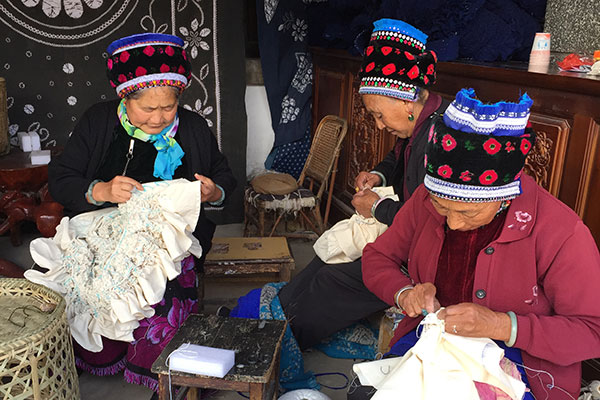
Local women work in a tie-dye workshop in Zhoucheng village, in Yunnan province. The craftsmanship is a cultural treasure. [Photo by Yang Feiyue/China Daily]
The Puzhen tie-dye workshop in Zhoucheng village doesn’t have any modern machinery despite being one of the largest such operations in Yunnan province’s Dali area.
On a recent day, a few big wooden buckets filled with dark blue liquid are seen in the front yard of this workshop in Southwest China.
Here, clothes in floral patterns flutter in the wind from ropes attached to poles as a bunch of elderly women in colorful traditional hats sew sheets.
“When you look at pieces of cloth under the sun, you will notice countless needle holes in them,” says workshop owner Duan Shukun. “That can only be realized by hand. Machines won’t do.”
Although similar artisans can be found in the provinces of Guizhou, Jiangsu and Sichuan, women from practically every household in Zhoucheng are involved in making tie-dye clothes. Some 6,000 people of the village’s 10,000 residents are employed by a few dozen tie-dye cloth producers in Zhoucheng.
The handicraft with local ethnic elements requires at least eight stages of delicate work and was named a national intangible cultural heritage in 2006.
At first, floral patterns are drawn on plastic sheets, then a tool resembling a needle is used to puncture the edges of the patterns. Then the punctured sheet is placed on white cloth and plastered with paint that percolates into the cloth. The resulting impression of floral patterns is then highlighted with dots in the cloth. A plastic sheet can be repetitively used as a mold.
The artisans then use needles and threads to tie up the dots into myriads knots before dipping the cloth in dye, mostly made of isatis roots.
When the cloth is taken out of the dye, the tied parts remain in their original white color while the rest is dyed, with various images also formed. A piece of cloth is dyed about three times a day for four days before the entire process ends. Tying up the knots is the most important and difficult of all the steps.
“A slight difference in the way a knot is made will result in subtle changes in the final image,” Duan says.
The tighter the knot, the clearer the image, he says. His wife, Duan Yinkai, 41, has been named a provincial inheritor of the tie-dye art. She has grasped more than 30 ways of tying up the knots.
On an average, workers know five to six different ways of tying the knots and receive further training at their workshop.
Duan Yinkai picked up the practice at age 10 by watching her parents on the job. The images that emerge once the knots are untied are sometimes unexpected. For example, if some 10 people tie the knots from the same pattern, 10 different images may follow, she says.
The couple took over the workshop in 2008 after the original establishment failed. In 2014, the workshop was named a national intangible cultural heritage production site by the Culture Ministry. Their workshop now hires roughly 2,000 temporary tie-dye workers, mostly older women, and a full-time workforce of more than 30.
The workshop’s annual output is worth 6 million yuan ($910,000), but its profit is around 300,000 yuan, Duan says.
The work is time-consuming. A piece of tablecloth that is 2 meters long and 1.5 meters wide is priced between 180 and 200 yuan, but on an average it takes more than a week to finish.
Low income is the biggest problem that keeps young people from getting into the business. Tie-dye workers usually earn 20 yuan for three to four days of work.
But the local government has paid attention to protecting the craft.
Duan Shukun says he has received assistance of 100,000 yuan from the government over the years. Now, he’s preparing to build a tie-dye museum in the hope that more young people will be encouraged to join in. Roughly 4,000 finished products, semifinished products and plastic sheets will be displayed at the museum that will likely be built in Zhoucheng.
